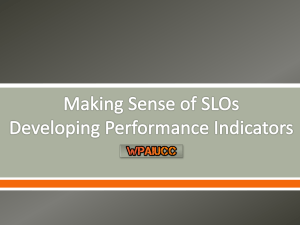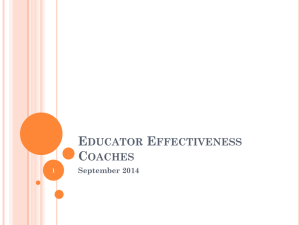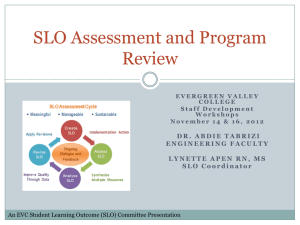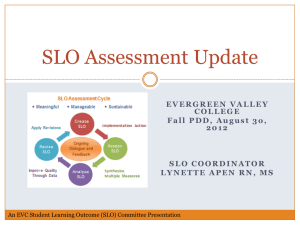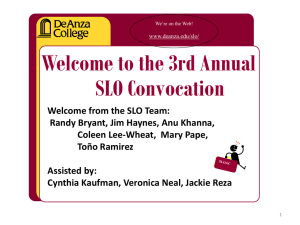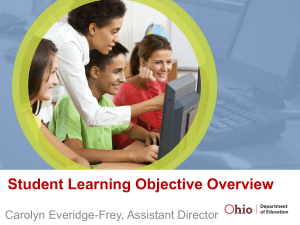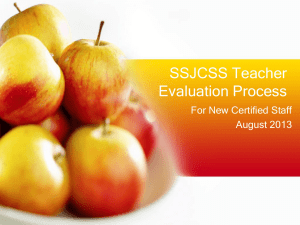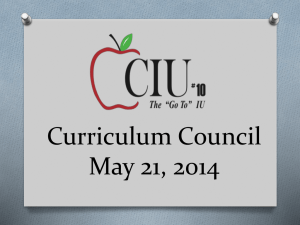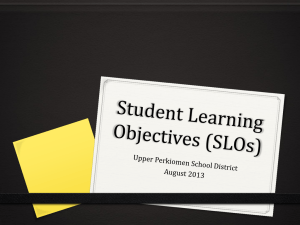SLO Presentation - Tulpehocken Area School District
advertisement
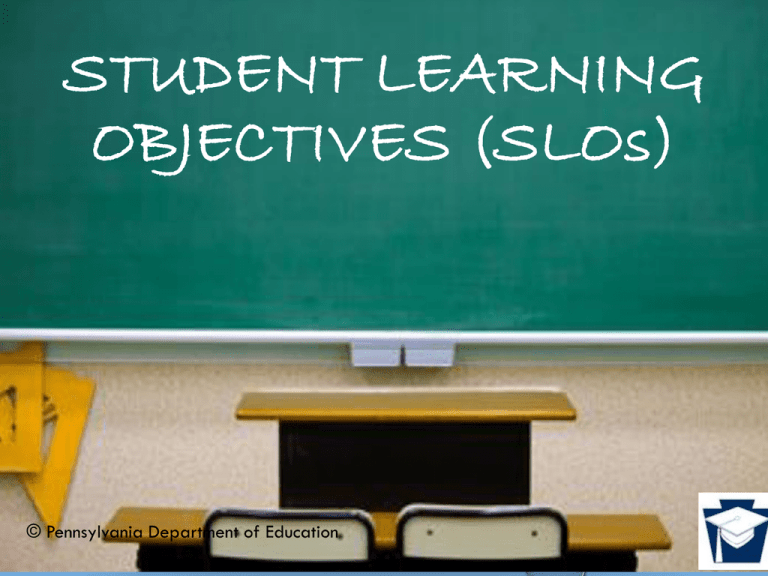
STUDENT LEARNING OBJECTIVES (SLOs) © Pennsylvania Department of Education THIS PRESENTATION • THIS PRESENTATION AND LINKS TO ALL OF THE SLO RESOURCES CAN BE FOUND ON THE SUPERVISION AND EDUCATOR EFFECTIVENESS WEBSITE • GO TO WWW.TULPEHOCKEN.ORG • CLICK ON STAFF BUTTON • LOOK FOR SUPERVISION AND EDUCATOR EFFECTIVENESS LINK 2 MODIFIED SCHEDULE K-6 Classroom Teachers, Art, Music, PE/Health/DE, Library, FCS 9:00-10:00 SLO in Auditorium 10:00-10:15 Break 10:15-11:15 SLO in Auditorium 11:15-12:15 Lunch (in Front of Cafeteria Please) 12:15-1:00 Talent Ed in Back of Cafeteria 1:00-3:30 SLO Collaboration with Department in Assigned Rooms 7-12 Classroom Teachers, Business/Computer, Special Ed(K-12) 9:00-10:00 SLO in Auditorium 10:00-10:15 Break 10:15-11:15 SLO in Auditorium 11:15-12:00 Talent Ed in Back of Cafeteria 12:00-1:00 Lunch (in Front of Cafeteria Please) 1:00-3:30 SLO Collaboration with Department in Assigned Rooms 3 OBJECTIVES • Review Teacher effectiveness requirements. What’s New? • Determine how to select an assessment for SLOs. • Explain how to complete the SLO template. • Demonstrate use of the Talent Ed software. 4 Teaching Professionals • All classroom teachers • If you plan, provide instruction, and give assessments, then you are a teaching professional. • You must do an SLO 5 6 7 Every Teaching Professional Designs an SLO Math History Physics Physical Education Chemistry Kindergarten Special Ed Journalism 8 Non-Teaching Professionals • • • • • • School Counselors School Psychologist Home School Visitor School Nurse Instructional Technology Specialist Anyone working under a teacher cert who does not provide direct instruction (planning, instruction, and assessment) to students. 9 Working Together to Create an SLO Collaborative development of an SLO is encouraged (e.g., similar content area or grade level teachers, interdisciplinary groups of educators) Student Learning Objective PDE’s Definition: A process to document a measure of educator effectiveness based on student achievement of content standards. 11 12 13 WHAT IS THE FOCUS? • COURSE? • ONE PERIOD OR ALL SECTIONS FOR THE COURSE? • SPECIAL EDUCATION, ELLS, GIFTED, ALL STUDENTS? • THINK OF A SKILL YOU KNOW THAT YOU WANT TO TARGET? • IS THERE AN AREA OF NEED? • IS THERE A TOPIC YOU WANT TO GET BETTER AT TEACHING? • REMEMBER, THIS IS A PERSONAL GOAL FOR YOU AS WELL AS YOUR STUDENTS! 14 Student Learning Objective Examples Simplified • I want to see how my students improve in subtraction from the beginning of the year to the end of the year. • I am going to give them a test in September to get baseline data. • I am going to set a goal to reach by April • I may assess them periodically throughout the year to benchmark their progress. • Baseline was 22% proficient • My goal is 50% proficient by April. 15 Student Learning Objective Examples Simplified • • • • • In my woodworking class, my students struggle every year with measurement for the final bookshelf project. I want to focus on measurement with every project to prepare them for this culminating activity. I am going to include a rubric for each project that includes a criteria for using accurate measurements. At the end of the course, I will use the same rubric to assess mastery on the measurement concepts used in the bookshelf project. I want 80% or more of my students to earn a 3 or better on the 4 point measurement rubric for this final 16 project. Student Learning Objective Examples Simplified • Every year, my students with special needs struggle to pass my Chapter 4 test. • I have data to show that, on average, only 70% of IEP students pass this test each year. • I want to set a goal for 85% this year (How?) 17 Student Learning Objective Examples Simplified • I teach students to use MLA Style in my spring honors research project, and there are always a lot of errors. • I am going to begin teaching and using MLA Style in the fall. • I have developed a 5 point rubric that can be used all year to assess the use of MLA in 4 smaller papers and the final research project. • I use the rubric for the first paper in September and only 40% of my students score a 4 or better. 18 • I want to show growth so that 80% of my students score a 4 or better on the final project. Don’t re-invent the wheel!!! • KEEP IT SIMPLE • MAKE IT A WORTHWHILE ENDEAVOR, SOMETHING YOU KNOW SHOULD BE YOUR FOCUS • IF YOU ARE IN A DIFFERENTIATED PHASE, THIS IS YOUR ACTION RESEARCH!!!!! • THE RECOMMENDED NUMBER OF STUDENTS IS 5 TO 100 STUDENTS (WITH A FEW EXCEPTIONS). 19 WHAT DOES AN SLO MEASURE? •GROWTH VS. MASTERY 20 GROWTH • AN ASSESSMENT GIVEN MULTIPLE TIMES THROUGHOUT THE COURSE • 4 SIGHTS, DRA, SRI, PHYSICAL FITNESS TEST, MUSICAL PERFORMANCE, • COULD BE A PORTION OF AN ASSESSMENT • GRAMMAR AND CONVENTIONS ASSESSED THROUGHOUT THE YEAR ON A RUBRIC USED TO ASSESS WRITING PROMPTS • SUMMARY OF A WRITTEN SCIENCE LAB USING THE SAME SCORING CRITERIA • SCORES ON PSSA/KEYSTONE-LIKE OPEN ENDED MATH QUESTIONS • SHOWS IMPROVEMENT OVER TIME 21 MASTERY • COULD BE ONE ASSESSMENT OR MULTIPLE ASSESSMENTS • LOOKS AT WHETHER OR NOT THE STUDENTS SUCCESSFULLY MASTERED THAT ASSESSMENT. • THINK OF IT LIKE THE PSSA/KEYSTONE EXAMS AND WHETHER OR NOT THE STUDENTS ARE PROFICIENT ON THAT ASSESSMENT 22 GROWTH OR MASTERY? • 4TH GRADE TEACHER • USING 4 SIGHT IN READING • LOOKING FOR STUDENT IMPROVEMENT BETWEEN FIRST, SECOND, THIRD, AND FOURTH ADMINISTRATION OF THE ASSESSMENT THAT YEAR. 23 GROWTH OR MASTERY? • 9TH GRADE PHYSICAL EDUCATION CLASS • STUDENTS GO THROUGH CONDITIONING FOR RUNNING THE MILE • AT THE END OF THE SEMESTER, STUDENTS ARE GIVEN AN ASSESSMENT TO DETERMINE IF THEY CAN RUN THE MILE • THE PERCENT OF STUDENTS ABLE TO RUN THE MILE IS CALCULATED 24 GROWTH OR MASTERY? • FAMILY CONSUMER SCIENCE • STUDENTS MUST PASS A TEST IN FOOD SAFETY AND SANITATION BEFORE BEING ALLOWED TO USE THE KITCHEN • STUDENTS TEST AND RETEST UNTIL THEY PASS IT • THE FCS TEACHER WANTS TO LOOK AT INCREASING THE NUMBER OF STUDENTS WHO PASS THIS TEST ON THE FIRST TRY 25 GROWTH OR MASTERY? • A GOAL TO IMPROVE STUDENT RESPONSES TO OPEN ENDED QUESTIONS IN SOCIAL STUDIES • PROVIDES INSTRUCTION THROUGHOUT THE YEAR ON HOW TO RESTATE THE QUESTION IN THE RESPONSE, PROVIDE A TOPIC SENTENCE, AND A CONCLUSION WITH EACH RESPONSE • A RUBRIC IS USED TO ASSESS THE THREE TOPICS ABOVE AND IS USED ALL YEAR FOR MULTIPLE OPEN ENDED RESPONSES (CONTENT GRADED SEPARATELY) • COMPARISON OF HOW WELL STUDENTS DID 1ST QUARTER, 2ND QUARTER, 3RD QUARTER AND 4TH QUARTER ON THESE 3 TOPICS. 26 • BTW, THIS DOES ALIGN TO CCSS FOR WRITING IN SOCIAL STUDIES GROWTH OR MASTERY? • CDT IS GIVEN 3 TIMES DURING THE YEAR IN ALGEBRA I • LOOK FOR STUDENTS TO HAVE AN OVERALL SCALE SCORE SHOWING IMPROVEMENT OF A MINIMUM OF ONE STANDARD ERROR ABOVE THE FIRST ADMINISTRATION SCORE. 27 GROWTH OR MASTERY? • CDT IS GIVEN 3 TIMES DURING THE YEAR IN ALGEBRA I • LOOKING AT THE LAST ADMINISTRATION, THE OVERALL SCORE FOR STUDENTS IS NO LESS THAN THE ALGEBRA I BOTTOM OF GREEN (1134). 28 GROWTH VS. MASTERY • IT IS NOT SO MUCH THE ASSESSMENT YOU USE BUT HOW YOU USE IT! 29 WHICH ASSESSMENT SHOULD I USE? • If you have a standardized assessment (4Sight, CDT, DRA, CFFA, SRI, etc.) USE IT!!!! • If you don’t have a a standardized assessment, you must have a rubric to evaluate the skills you are assessing. • You must complete the Performance Task framework in addition to the slo document. • You may not use PSSA/Keystone/AP (Timeline) • Think about an assessment on which you “should” focus to show personal/professional growth. 30 QUESTIONS ABOUT ASSESSMENT? • STAND UP! • SHARE WITH THE PERSON NEXT TO YOU: WHICH ASSESSMENT ARE YOU THINKING ABOUT USING? • WHAT ARE THE SKILLS YOU WANT STUDENTS TO MASTER OR TO SHOW GROWTH? • WHY IS THIS AN AREA FOR YOUR OWN PERSONAL GROWTH? 31 TEACHER CREATED VS. STANDARDIZED ASSESSMENTS • IF YOU ARE USING A TEACHER-CREATED ASSESSMENT, YOU MUST COMPLETE THE PERFORMANCE TASK TEMPLATE IN ADDITION TO THE SLO. • YOU MUST HAVE A SCORING RUBRIC FOR A PERFORMANCE TASK, AND/OR AN OPEN-ENDED ASSESSMENT OR ITEM. • YOU MUST HAVE A TEST BLUEPRINT FOR A TEST. 32 SAMPLE PERFORMANCE TASK MODELS • PE GRADE 3 • ECONOMICS • MATH GRADE 1 (EVERYDAY MATH EXAMPLE) • OTHERS CAN BE FOUND ON WWW.PDESAS.ORG • CLICK ON INSTRUCTION • CLICK ON STUDENT LEARNING OBJECTIVES • CLICK ON MODELS 33 OTHER HELPFUL DOCUMENTS • LISTED ON THE COVER OF THE HANDOUT • LINKS TO ALL SUPERVISION INFORMATION IS ON OUR SUPERVISION/TEACHER EFFECTIVENESS LINK OFF OF THE STAFF PAGE OF OUR WEBSITE 34 Goal & Objectives Goal: Build Student Learning Objectives (SLOs) for use in guiding instruction and determining student mastery and/or growth as part of Pennsylvania’s Teacher Effectiveness system. Participants will: 1. Review each section of the “SLO Process Template ” and the “Help Desk” definitions. 2. Complete the SLO Process Template AND applicable Performance Measures. 35 Outline of the Build Module Building Preview SLO Template & Help Desk Classroom Context SLO Goal Performance Measures Performance Indicators Elective Rating 36 STUDENT LEARNING OBJECTIVES Preview Section 1: Classroom Context General Description • • • Contains demographic information about the educational setting Articulates the course, grade(s), and students the SLO is based on Provides class size, frequency, and duration data 38 Section 1: Classroom Context Element Definition 1a. Name Educator’s full name 1b. School Name of school(s) to which the educator is assigned during the current year. 1c. District Name of district to which the educator is assigned during the current year. 1d. Class/Course Title Name of the class/course/content upon which the SLO is based. 1e. Grade Level Grade level(s) for those students included within class/course identified in Element 1d. 1f. Total # of Students 1g. Typical Class Size Aggregate number of students (estimated, across multiple sections) for which data will be collected and applied to this SLO. The “average” number of students in a single session of the class/course identified in Element 1d. 1h. Class Frequency The frequency and time frame in which the class/course identified in Element 1d is delivered. 1i. Typical Class Duration The average number of minutes allocated to deliver a “session” of the class/course 39 identified in Element 1d. Section 2: SLO Goal General Description • • • Contains a statement about the “Big Idea” the SLO is based upon Provides the specific PA standards associated with the goal Articulates a rationale about the Goal Statement 40 Section 2: SLO Goal Element Definition 2a. Goal Statement Narrative articulating the “big idea” upon which the SLO is based. 2b. PA Standards References the PA Standards that align with the Goal Statement. Numeric references to PA Standards are found at: http://www.pdesas.org/standard/views References additional professional organization standards that align to the Goal Statement. 2c. Rationale Narrative providing reasons why the Goal Statement and the aligned standards address important learning for the class/course/content area. 41 Section 3: Performance Measures General Description • • Identifies all performance measures, including name, purpose, type, and metric Articulates the administration and scoring details, including the reporting Note: Section 3 is based upon high-quality performance measures aligned to the targeted content standards (see Assessment Literacy Series: Quick Start PA materials) 42 Section 3: Performance Measures Element 3a. Name Definition List the name of each Performance Measure for which a Performance Indicator is established in Section 4a. 3b. Type Identify the type(s) of Performance Measure(s) listed in 3a. From the given list, select all types that are applicable. 3c. Purpose The purpose statement for each Performance Measure that addresses who, what, and why. 3d. Metric The metric used by the performance measure to evaluate the performance indicator. 3e. Administration Frequency The timeframe during the school year that the Performance Measures are administered to students. For Performance Measures administered more than one time, the frequency (e.g., quarterly) is annotated. 3f. Adaptations/ Accommodations Identifies and lists any unique adaptations or special accommodations needed for IEP, ELL, Gifted IEP, or Others to complete the tasks within each Performance Measure. 43 Section 3: Performance Measures (cont.) Element Definition 3g. Resources/Equipment Identifies any unique resources, including equipment and personnel, associated with each Performance Measure. Identifies the scoring “tools” for each Performance Measure 3h. Scoring Tools 3i. Administration & Scoring Personnel 3j. Performance Reporting For objective measures, scoring keys and SCR (Short Constructed Response) /ECR (Extended Constructive Response) rubrics are identified. For subjective measures, the name of each scoring rubric and accompanying guidelines are listed. Identifies two key individuals: the person administering the Performance Measure(s) and the person scoring. This is particularly important for subjective measures in which the subject matter expert is both administrator and scorer. Identifies the manner by which student performance on the Performance Measures will be communicated to others (as appropriate). The “Summary” selection is provided to describe student achievement for linked and/or weighted Performance Measures. 44 Section 4: Performance Indicators General Description • • • • Articulates targets for each Performance Measure Includes all students in the identified SLO group May include a focused student group Affords opportunity to link and/or weight indicators 45 Section 4: Performance Indicators Element 4a. PI Targets: All Student Group 4b. PI Targets: Focused Student Group (optional) Definition A description of the expected level of achievement for each student in the SLO population (as defined in Element 1f) based on the scoring tool(s) used for each performance measure (as listed in Element 3a). A description of the expected level of achievement for students in a subset of the SLO population (as defined in Element 1f) based on the scoring tool(s) used for each performance measure (as listed in Element 4a. Subset populations can be identified through prior student achievement data or through content-specific pre-test data. 4c. PI Linked (optional) 4d. PI Weighting (optional) A description of any performance measures for which a student must meet a specific achievement level in order to meet achievement levels on additional performance measures. An assignment of proportional values among PIs prior to aggregation and 46 application to Section 5. Weighting can be applied when there are more 4 than one performance indicator. 6 What is “Assessment Literacy”? The skills, knowledge, and concepts associated with sound assessment practices, including the critical review of quality evidence. Assessment Life Cycle Examine Validity Evidence Establish Assessment Purpose(s) and Design Administer Assessment and Report Results Build Test Specifications & Blueprint Develop Items Review Forms Create Operational Forms & Administrative Guidelines Develop Scoring Keys and Rubrics 48 Principles of Well-Developed Measures Measures must: • Be built to achieve the designed purpose; • Produce results that are used for the intended purpose; • Align to targeted content standards; • Contain a balance between depth and breadth of targeted content; • Be standardized, rigorous, and fair; • Be sensitive to testing time and objectivity; and, • Have score validity and reliability evidence. 49 Section 5: Elective Rating General Description • • Classifies percentages of students who are meeting the Performance Indicator targets into four levels: Failing, Needs Improvement, Proficient, and Distinguished. Selects the overall SLO rating (see Section 5b). 50 Section 5: Elective Rating (cont.) Element Definition Four levels of projected performance regarding the PI, reflecting a continuum established by the educator prior to the evaluation period. 5a. Level Each performance level (i.e., Failing, Needs Improvement, Proficient, and Distinguished) is populated with a percentage range such that 0% to 100% meeting expectations is distributed among the levels. Given the actual performance regarding the PI, the principal or evaluator identifies one of four performance levels. 5b. Rating This section is not completed until after performance data are collected, reviewed, and evaluated against each performance indicator, and in the aggregate, against 5a criteria. Notes/ Explanation Provides space for the educator to articulate influences, factors, and other conditions associated with the assigned rating as well as to reflect on purposeful review of the data. 51 This section is not completed until after performance data are collected, reviewed, and evaluated against each performance indicator, and in the aggregate, against 5a criteria. Section 5: Elective Rating (cont.) Independent Performance Indicators • SLO based on 100 students in each indicator PI #1 Jumping PI #2 Hopping PI #3 Sprinting Met Expectations 25 50 75 Total Number of SLO Students 100 100 100 • The sum of all students that met expectations (25 + 50 + 75) • The sum of all students (100 + 100 + 100) 52 Resultant: (150/300 = .50 or 50%) YOUR TASK THIS AFTERNOON • RECEIVE TRAINING IN TALENT ED • DETERMINE YOUR AREA OF FOCUS FOR THE SLO (REMEMBER TO COLLABORATE IF POSSIBLE) • DEFINE THE ASSESSMENT(S) USED • COMPLETE PEROFORMANCE TASK FRAMEWORK AND RUBRICS/BLUEPRINTS IF NECESSARY (DONE IN TALENT ED WITH ATTACHMENTS) • COMPLETE SLO DOCUMENT (IN TALENT ED) 53 TIMELINE • Slos and task frameworks are due for approval by the end of the day on october 13th. • Conversations with your principal between now and October 13th to review your goals and receive feedback. • ½ day on October 13th to finalize the documents and assessments and submit them for approval. • If you plan to attend the BCIU common inservice in october you must have your slo approved by your principal 54 SUPPORT • Ask three before me…… 1. Talk about your ideas with your department peers 2. Department Coordinators were trained in slos last year by bciu, so they should be able to answer many questions for you. 3. Principals will be floating around to your classrooms to provide support and answer questions • I wish I could read all of your slos, but there just is not time. I will be around to help if you have questions. 55 CLASSROOMS BY DEPARTMENT MATH: ROOM 117 ESL: ROOM 414 ELA: ROOM 413 WORLD LANGUAGE: ROOM 414 SOCIAL STUDIES: ROOM 115 BUSINESS/COMPUTER: ROOM 201 SCIENCE/TECH ED/AG ROOM: 107 JSHS SPECIAL ED/GIFTED: ROOM 412 PE/HEALTH/DE: LIBRARY GRADES K-1-2: CHORAL SUITE ART/MUSIC: LIBRARY GRADES 3-4: CAFETERIA REAR LIBRARY: LIBRARY GRADES 5-6: CAFETERIA REAR FCS: LIBRARY GRADES K-6 SPECIAL ED/GIFTED: ROOM 412 56
